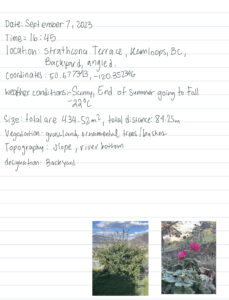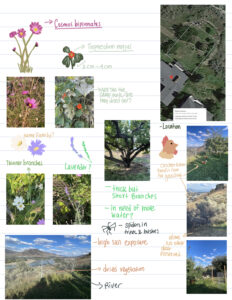Date: September 7, 2023
Time: 16:45
location: Strathcona Terrace, Kamloops, BC,
Backyard, angled.
Coordinates: 50.677343,-120.352346
weather conditions:-Sunny, End of summer going to fall
– 22C
Size: total are 434.52 m2, total distance: 89.25m
Vegetation: grassland, ornamental trees/bushes
Topography: slope, river bottom
designation: Backyard
My backyard is in the heart of a suburban neighborhood and strathcona park/ river bank, this backyard is a thriving ecological diversity. The plant life is The centrepiece of this ecosystem, it has a diverse types of plants some that I used my app to identify: Cosmos bipinnatus which is a flowering plant and its in the daisy family, this is a beautiful flower with bright petals and I also identified tropaeolum majus which is a bright orange/red petal flower that attracts lots of pollinators like bees and butterflies. I also noticed more flowers around the Cosmos bipinnatus they seemed to look very similar, and I was wondering if they were in the same family. Along the perimeter, there is shrubs which I am not sure if they are native to Kamloops but while in my observations they provide shelter for birds and small mammals like deer, every morning there is a deer resting in the same area. There is also chickens living in this backyard living all year round. This backyard is also a place for relaxation and enjoyment, it showcases a coexistence between humans and nature.
My three questions are: Does vibrance of flowers effect increase the mental health of humans? , How does the presence of free-range chickens in a backyard effect the plant growth and soil when compared to a control area without chickens?, how does the soil impact the thickness and growth rate of trees in the backyard?


Hi, you can use your backyard though with yards you have to be careful of the area you have to work with and plan your study at the appropriate scale. For instance, it may be hard to study trees as you may not have enough replicates. Also, make sure to distinguish between native and non-native plants and ecosystems. You can certainly study non-native areas but you seem unclear as to which your backyard is or if it is a mix. Your first question on mental health is not an ecology topic so would not be appropriate for this course.
As you go through the next few modules you will work on thinking of and refining your questions.
Robyn